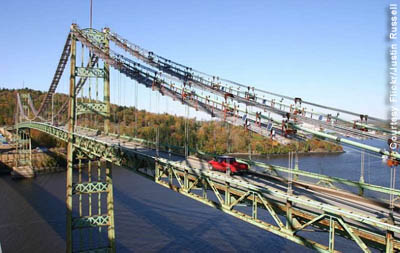Waldo-Hancock Suspension Bridge
44 33 38.5 N
68 48 07.1 W
The Waldo-Hancock Suspension Bridge was the first bridge to make use of the Vierendeel truss in its two towers, giving it an effect that David Steinman called "artistic, emphasizing horizontal and vertical lines."

The Waldo-Hancock Suspension Bridge is a historically and technologically significant example of the suspension bridge type. It is the first suspension bridge built with the Vierendeel truss towers. Named after Belgian engineer Arthur Vierendeel, the chief characteristic is the absence of diagonals as rigid frame construction connects the posts to the chords. The advantage is the economy of material and construction as well as aesthetics. These towers became almost standard in suspension bridge design. Steinman combined the innovative Vierendeel truss design with a successful attempt to arrange the spacing and proportions of the members for aesthetic affect. He sought to emphasize straight lines with simple elements in repetition and alteration in order make the design compatible with the natural rocky setting.
In addition to its innovative design, the bridge has been a key structure on U.S. Route 1 connecting down east Maine to the international maritime commerce of the coast. With its completion, travelers driving to the coast no longer needed to take an overcrowded and outdated ferry to get there. The Waldo-Hancock Suspension Bridge made the trip much faster and easier for everyone.
On December 30, 2006, the Waldo-Hancock Bridge was officially closed and the replacement bridge, Penobscot Narrows Bridge, was opened to traffic. The Waldo-Hancock Bridge was completely removed in 2013.
Resources
- Petroski, Henry. Engineers of Dreams: Great Bridge Builders and Spanning America, Vintage Press, 1996.
- Plowden, David. Bridges: The Spans of North America, W.W. Norton and Company, 2001.

